|
The town in the late 1930s
Living conditions for the average
Darlaston family had greatly improved since the end of
the First World War. The cramped housing conditions in
the early 1920s had almost become a thing of the past
thanks to the council’s municipal housing schemes. Large
numbers of council houses had already been built to the
south of George Rose Park and at Rough Hay.
Employment
was plentiful, the larger factories had recovered from
the recessions in the late 1920s and early 1930s, and
were working flat-out. Shops of all kinds could be found
in King Street, Pinfold Street, and Church Street,
providing all of a family’s weekly needs. There were
plenty of good schools, and places to go in the evening,
in the form of cinemas, pubs, and work’s social clubs.
Life in the town was better than ever, and people were
generally happy and contented.
The onset of war
To many people war seemed
inevitable. Bad news continued to come from Germany,
where Hitler clearly had his own vision of the world to
be, and showed no sign of wishing to compromise his
plans.
On 31st March, 1937 Britain and
France guaranteed to defend Poland from any attempted
invasion by Germany, which had been interested in
acquiring the country for some time. The Poles greatly
distrusted Hitler and his motives, after a long dispute
over the ownership of a strip of Polish land known as
the Polish Corridor, which ran alongside the German
border. In 1938 alarm bells sounded when Germany invaded
Austria, and sounded again in March 1939 when Germany
took over Czechoslovakia. |
 |
|
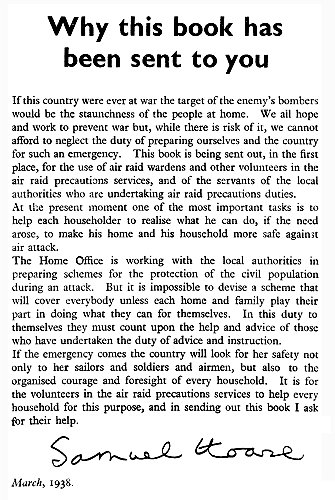 |
|
A
government booklet from March 1938. Courtesy
of Christine and John Ashmore. |
|
|
On 1st September, 1939 Germany
invaded Poland, so war was now unavoidable. Two days
later Neville Chamberlain declared war with Germany.
The initial effects on family life
Most people were not surprised when
war was declared. A feeling of comradeship in the face
of adversity prevailed, along with the determination to
do all that was necessary to support the country in
winning the war. The first major impact on local life
occurred in October 1939 with the introduction of
conscription. The government announced that all men
between the ages of 18 and 41, who were not working in
reserved occupations, could be called to join the armed
forces. They would receive their call-up papers in the
post, which included details of where and when they had
to attend a medical, and begin military training.
|
| |
|
Read about
conscription |
 |
| |
|
|
Employment was plentiful and
people worked long hours to support the war effort.
At the outset of war, factories came under the
control of the Ministry of Supply, a department set
up to coordinate the supply of essential arms,
ammunition, and equipment for the armed forces.
Large amounts of weapons,
tanks, military vehicles, and equipment of all kinds
were necessary. This work would keep British
industry hard at work during the whole of the war.
Some factories concentrated on military vehicles,
such as Old Park Works in Wednesbury, where
Valentine tanks were built. The factory also
produced 435 Churchill tanks, 75 Cromwell tanks, and
tank hulls for other manufacturers. Rubery Owen made
aircraft wings and frames, steel helmets, lifeboats,
and carried out all kinds of machining, Wellman
Smith and Owen manufactured shell forging machines,
bridge laying equipment, cranes, and shot furnaces.
Atlas Works, owned by GKN was
asked to double the output of cold-forged nuts and
bolts, and the factory was greatly extended. Half
the cost (£29,000) came from the government. By the
end of the war Atlas Works covered an area of over
20 acres and employed about 3,000 people.
Garringtons, also owned by GKN
produced shells. In July 1940 a shell forging plant
was built at the works by the Admiralty at a cost of
around £100,000. £261,433 was also spent on hammers,
presses and other plant by the Government.
F. H. Lloyds who had the
largest foundry in Europe, made all kinds of
castings, especially for tanks. Large numbers of
women worked in the factories to replace the men who
had gone to war. They carried out all kinds of work,
and were essential to keep the factories operating.
Some women joined the Women's
Voluntary Service (WVS), and carried out an
essential job, doing whatever was needed from
providing tea and refreshments for fire fighters,
collecting scrap metal for the war effort, and
knitting socks, balaclavas etc. for service men.
The first part of the war
These were worrying times, due
to the continuing bad news from Europe. In April
1940 Germany invaded Denmark, followed by Belgium,
Holland, and Luxembourg in May, and Norway in June.
On the 12th May the German army entered France, and
on the 27th May, the evacuation of 340,000 British
and French soldiers from the beaches of Dunkirk
began.
On the 10th May Winston
Churchill replaced Neville Chamberlain as prime
minister, and on the 10th June, Italy declared war
on Britain and France. Eleven days later Italy
invaded southern France, and on the 22nd June France
surrendered to Germany. |
|
Gas Masks
The British Government believed
that some form of poison gas attack would be
inevitable and so gas masks were issued to everyone
living in Britain. By 1940 about 38 million had been
issued.
Adults’ masks were black, and
children’s masks were in bright colours of red,
blue, or green, with bright eye-rims. They became
known as “Mickey Mouse” masks, to make them less
frightening and more appealing.
Each mask came in a strong
cardboard box with a long string handle, which would
be used to carry it over your shoulder. People were
expected to carry them everywhere, but in practice
few did.
Air raid wardens would carry
out inspections and anyone who lost their mask would
be required to pay for a replacement.
They were also available for
young babies in the form of a respirator, which
totally enclosed the child. They came complete with
an air filter and hand-operated air pump. |
 |
|
Fire watching
In September 1940 a law was
passed which required factories and businesses to
appoint employees to undertake fire watching. They
had to keep a look out for incendiary bombs which
were dropped in vast quantities at night. They were
quite small, and ignited on impact to start a fire.
Fire watchers were a common
sight in Darlaston, often seen on flat roofs which
were a good vantage point. Many people were involved
in the activity. Some local factories also had a
number of employees who were trained in fire
fighting, and would be on hand in case of an
emergency. |
 Fire watching at the Woden
factory run by The Steel Nut & Joseph Hampton
Limited was organised by the Local Defence
Volunteers, the precursor to the Home Guard.
Notices like the one above were issued to
members of staff to inform them when they were
required for fire watching duties.
Fire watching at the Woden
factory run by The Steel Nut & Joseph Hampton
Limited was organised by the Local Defence
Volunteers, the precursor to the Home Guard.
Notices like the one above were issued to
members of staff to inform them when they were
required for fire watching duties. |
|
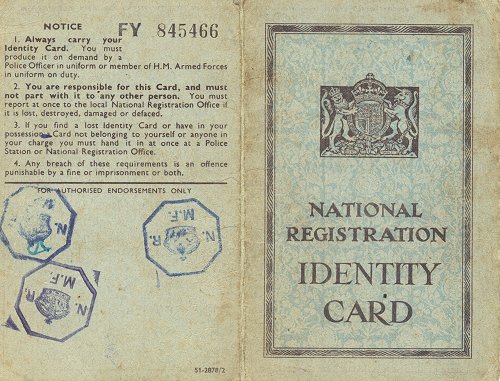
An adult's identity card.
Courtesy of Brian Groves. |
Identity cards were introduced
under the terms of the National Registration Act of
1939.
Everyone, including children,
had to carry an identity card at all times to show
who they were, and where they lived.
Initially they were buff
coloured, but after 1943 Adults' cards were coloured
blue. |
|
Anderson Shelters
The Prime Minister, Neville
Chamberlain placed Sir John Anderson in charge of
Air Raid Precautions in November 1938. He asked
William Patterson to design a small air raid shelter
that could easily, quickly, and cheaply be erected
in people’s gardens. This became known as the
Anderson Shelter.
It consisted of 6 curved sheets
of corrugated, galvanised steel, bolted at the top,
with corrugated sheets at the back, and an entrance
at the front. The shelter was half-buried, then
covered in earth, and measured approximately 6ft.
6in. by 4ft. 6in. It could accommodate six people.
They were given free to the poor, and could be
purchased by anyone earning over £5 a week.
The shelters were distributed
to towns and cities that were perceived to be under
threat from air raids. Within the first two years,
two and a quarter million Anderson shelters had been
erected. Many families spent long and cold nights in
their shelter after hearing the air raid warning
sirens. The winters of 1940 and 1941 were especially
cold. |

The inside of the identity card.
Courtesy of Brian Groves. |
 |
A child's identity card.
Courtesy of Brian Groves. |
|
The inside of the card.
Courtesy of Brian Groves. |
 |

Anderson air raid shelters in a
back garden in Ward Street, Walsall. Courtesy of John
and Christine Ashmore. |
Because the air raid shelters
were cold and damp, it could be an unpleasant
experience to spend a night there. Sometimes water
would seep through the earth floor, adding to the
discomfort.
Benches to sit and sleep on would be
built around the inside walls, and candles and
matches were a necessity for lighting.
Due to the
blackout, no light could be showing at night, and so
Hessian sacks were often hung across the open
doorway. Sometimes a family would prefer to stay in
the house during an air raid to avoid the discomfort
of the shelter. They would crawl under the stairs
where possible, or even sit under the kitchen table.
Although few Anderson shelters
have survived, some of the corrugated steel sheets
are still in use as garden fencing.
There were also public air raid
shelters near to public buildings, school air raid
shelters adjacent to schools, and factory air raid
shelters for factory workers. |

An Anderson shelter in a back garden.

An invoice from the local
council for an Anderson
shelter.

An impression of the air raid shelters
built for Pinfold Street School.
| |
|
Read about how to use
an air raid shelter |
 |
| |
|
 |
The German U-boats, mines,
aircraft, and surface ships sunk vast numbers of
allied merchant ships, which led to shortages of all
kinds, and the introduction of rationing in 1940.
Everyone was issued with a ration book, which
contained coupons that entitled the owner to buy
food and clothes, and helped to prevent people
hoarding things. The coupons were cut out and signed
by the shopkeeper.
Everyone had to register with
local retailers, whose details were stamped in the
book. Items could only be purchased from their
shops. Rationed items included meat, eggs, fats,
cheese, bacon, sugar, and clothes. Each person was
allowed a new set of clothes each year. Food
retailers had to register with the Ministry of Food,
and were provided with a list of what they could
sell.
Although rationing was strictly
adhered to, the more wealthy members of society
could supplement their food allowance by eating out.
Restaurants were exempt from rationing, which caused
resentment amongst the working classes. To minimise
this, new rules were put into place. A meal could
cost no more than 5 shillings, and consist of no
more than 3 courses. Meat and fish could not be
served at the same sitting.
|
|
Due to the German blockade,
citrus fruits and bananas were not available. Coffee
was also scarce and so alternatives were made from
roasted barley seeds and acorns. People often kept
chickens in their garden as a source of meat and
eggs, and also rabbits. Because milk was in short
supply, most people relied on powdered milk.
Powdered eggs were also popular.
The “Dig for Victory” campaign
started early in the war, and helped people to cope
with the shortages by growing their own fruit and
vegetables. Some schools also took part by
encouraging the children to cultivate a small piece
of land near the school.
The shortages in the shops
continued for many years after the war had ended.
Rationing remained until 1954. |
 |
|
 |
|
A clothes
rationing book and one of the 4 pages of coupons. |
|
Germany’s ruthless expansion
programme continued in 1941 with the invasion of
Yugoslavia and Greece in April, and the invasion of
Russia in June. In December of that year the United
States formally declared war on Germany, Italy, and
Japan. In September 1940 the three countries had
signed the Tripartite Pact, agreeing to support one
another in the war.
The bombing campaign
By the summer of 1940 Hitler
had decided to invade Britain. In July of that year
the German air force, the Luftwaffe, began making
daily bombing raids on British factories, ships and
military establishments, particularly airfields. On
the 7th September the London blitz began, when the
Luftwaffe destroyed many houses, killing 430 people
and badly injuring 1,600 people on the first day.
Hitler believed that he could lower people’s moral
by bombing civilian houses, and force the country to
surrender.
Due to the large number of
factories in Darlaston, the town could have been a
prime target, but German intelligence on British
industry was poor. Birmingham suffered badly due to
its many factories and large population. Around
2,000 tons of bombs were dropped on the city,
killing 2,241 people and seriously injuring over
3,000 people. Coventry also suffered, but to a
slightly lesser extent. The government tried to
confuse the German bombers by enforcing a
'blackout', during which street lights were turned
off, car headlights were covered, and people had to
use blackout curtains to prevent house lights being
seen. It became dangerous to go out at night,
particularly on dark nights. Place names were
removed from buildings to confuse any enemy
paratroopers, and road signs were often turned round
to further increase the confusion.
Luckily Darlaston got off very
lightly, only 3 bombs were dropped on the town. The
first bomb fell on the 5th June, 1941 when a German
bomber attempted to drop a bomb on the Rubery Owen
factory. The large bomb fell short of its target and
badly damaged 5 houses in Lowe Avenue, killing 11
people in the process. Several other houses were
damaged to a lesser extent. |
| The aftermath of the
bombing in Lowe Avenue.
Courtesy of Brian Groves.
|
 |
 |
My mother recalled seeing it
pass over Moxley Road, where my family lived,
glowing red at the front, and making a whistling
sound as it travelled through the air. After a short
time it went quiet, then there was a loud explosion,
so the bomb had obviously detonated.
My grandmother lived in Berry
Avenue, and as the explosion appeared to come from
that direction, my mother hurriedly went there to
see if everyone was OK. On discovering that the bomb
had passed over Berry Avenue she thought of her
brother and sister-in-law who lived in Lowe Avenue,
so she continued her journey and saw the
devastation.
The houses destroyed were
numbers 34 to 42. No air raid warning had been
given, and so the occupants were in their houses
rather than in the air raid shelters.
Although it was a terrible and
sad event, it could have been much worse. Had it
landed on its target, hundreds could have been killed
or injured. |
The casualties were as follows: |
| Number 34 Lowe Avenue - Henry John
Mumford, age 44, married to Emily. |
| Number 34 Lowe Avenue - Emily Mumford,
age 44. |
| Number 36 Lowe Avenue - Ellen Mills, age
60. |
| Number 38 Lowe Avenue - John Woodward,
age 26, married to Mary. |
|
Number 38 Lowe Avenue -
Mary Woodward, age 25. |
| Number 40 Lowe Avenue - Ethel Cross, age
41. |
| Number 40 Lowe Avenue - Elsie May
Prestidge, age 23, mother of Malcolm. |
| Number 40 Lowe Avenue - Malcolm Thomas
Prestidge, age 4 months. |
| Number 42 Lowe Avenue - Richard Perrins,
age 47, father of Henry and Frank. |
| Number 42 Lowe Avenue - Henry Perrins,
age 15. |
| Number 42 Lowe Avenue - Frank Perrins,
age 12. |
Within a few weeks almost all traces of the bombing
had gone. The council quickly stepped-in and
repaired the houses. |

The Groves family
who lived at number 43 Lowe Avenue, from
the mid 1940s. This view of the family
is taken in the garden behind the house.
Left to right: John, Mary with Peter on
her lap, Tom junior, Tom senior, Derek,
and Brian. Courtesy of Brian Groves. |
| Another bomb fell on All Saints' Church in
Walsall Road on the 31st July, 1942. The church was
completely destroyed, leaving a crater 50 feet deep
and 40 feet across. Luckily no one was hurt.
The bomb’s intended target was the nearby Atlas
Works where around 2,000 people were on the night
shift. My father worked at the Steel Nut and Joseph
Hampton Limited, in All Saint’s Road, known as ‘The
Woden’. He remembered being shocked at the
unexpected sight of the crater and the destruction. |
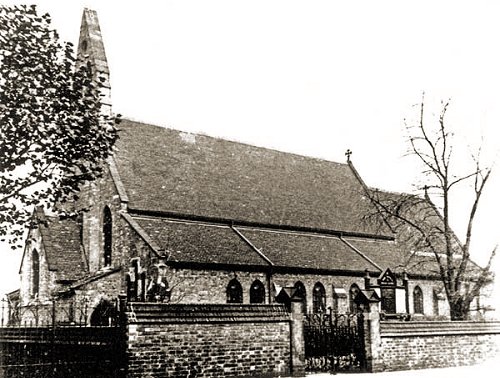
All Saints' Church, Walsall
Road. |
 |
The interior of the
church. |
|

Another view of the interior of the
church. From an old postcard. |
|

What was left after the
explosion. |
|
On the 4th August, 1942 the
church council formed a restoration committee and
made plans for the rebuilding of the church.
Services continued to be held in the All Saints' Day
School, which partially survived the blast. Over the next few years
they raised £10,000 towards the new church and also
received £28,320 from the War Damage Commission.
On the same night as the
bombing of the church, another bomb fell by the
Railway Tavern at James Bridge, hitting the cinder
wall in front of the pub. Luckily it did not
explode, it just sank into the soft earth. The bomb had been aimed at
one of the factories in the area, possibly F. H.
Lloyd & Company, E. C. and J. Keay Limited, or the
Darlaston Nut and Bolt Company’s factory in Cemetery
Road, known locally as ‘Bogie Wilkes’. Had the
500lb. bomb exploded it would have not only
destroyed the pub, but also the railway station, the
nearby cottages, and much of Wilkes' factory. When a
bomb disposal team arrived the next day, they
discovered that the bomb was buried several feet
under the ground, due to the soft earth. This
complicated the whole process, and it took many
hours to safely defuse and remove it.
By the time the German bombing
campaign had ended, over 43,000 civilians had been
killed, and over 1,000,000 houses were destroyed or
damaged.
Darlaston people greatly
enjoyed the fun fairs that were held on the Wake
Field by Pat Collins. There was always something new
to look forward to, because Pat was a great
innovator. It is easy to imagine that the enforced
wartime blackout would have prevented such fairs
taking place. It may have stopped others, but not
Pat Collins', he found a way to overcome the
restrictions. In April 1940 he introduced his
blackout fair at Darlaston and Walsall. It was a
completely covered fair, with all of the usual
attractions undercover. It must have been a great source
of enjoyment, especially at a time of so many
restrictions, rationing, and shortages.

From the Walsall Observer, 30th April, 1940.
The mid-war years
The British Restaurant
British restaurants were run by
local authorities, and local committees to provide
cheap meals for the community. They were essential
in areas that had been badly hit by the bombing, and
essential for people who had run out of rationing
coupons. Workers who had no canteen also used them.
The restaurants were set up by the Ministry of Food,
and run on a non-profit making basis. The maximum
price for a meal was 9 pence. By the end of 1944
there were 1,931 of them in the UK, some of which
had been set up in schools and church halls.

In Darlaston, the Women's
Conservative and Primrose League Hall in Bilston
Street, built in 1930, was converted into a British
Restaurant. It acquired the nickname of "The
Trough", and after the war became the Civic
Restaurant, which remained open for many years. The
restaurant was extremely popular and attracted
customers from many surrounding towns. The building
still survives today on the corner of Bilston Street
and Cramp Hill, and is used by the Darlaston Sons
and Daughters of Rest. |
 |
The British Restaurant
building in Bilston Street, as it was in 2006. |
|
Fund raising and collecting for the war effort
The War Savings Campaign was
initiated by the War Office in 1939 to support the
war effort. Several saving schemes were introduced,
the first being the National Savings Scheme where
you purchased savings stamps and stuck them onto a
card.
The scheme became a great
success, large numbers of people purchased the
stamps, at banks, post offices, and savings kiosks.
Other options were war bonds, savings bonds, and
defence bonds, advertised with the slogan “Lend to
defend the right to be free.”
People were also asked to
contribute to various money raising schemes such as
Warship Week, Wings for Victory Week, Spitfire Week,
all raising much needed cash for armaments. |
 |
|

Courtesy of Christine and John Ashmore. |
Although we tend to think of
recycling as something new, it became an important
way of dealing with the many shortages. People
collected silver wrapping paper, empty toothpaste
tubes, and even unwound wool from old jumpers and
socks. Housewives were urged to hand over their
aluminium pots and pans to become the raw material
for aircraft production. Wrought iron gates and
fences were removed and taken to factories to be
melted down. Paper was in short supply, and so
newspapers were only a few pages long. People kept
the paper which was either burnt on the fire, or
recycled.
Because coal was in short supply, salt
water would be sprinkled on it to make it burn more
slowly, and fallen tree branches could be collected
to supplement the often meagre supply.
Preserves
such as jam were an important way of preserving
fruit when it was plentiful. Similarly eggs were
preserved by storing them in a solution of
isinglass. The shortage of petrol led to the
government asking all drivers to observe a 40mph.
speed limit to help conserve fuel. |

The programme for a concert in
April 1943 that was held at the Regal Cinema to
raise money for the Air Training Corps Welfare Fund.
Courtesy of Christine and John Ashmore. |
|

The programme details.
Courtesy of Christine and John Ashmore.
|
| Albert Peters -
Darlaston's Artist Sign Writer |
| A once well known and well respected figure in
the town was Albert Peters, who turned sign writing
into a form of high art. His signs could be found
throughout Darlaston and the surrounding towns. They
varied from simple name signs, through to pub signs,
and the large signs that he produced for the local
authority, which became landmarks in their own
right. They were works of public art, that were
greatly appreciated by the local population.
I have included photos of some of his better
known signs below. They came from the collection of
the late Howard Madeley. |

Albert Peters. |
|

Albert Peters standing below
his poster to advertise Darlaston's part in 'Salute
the Soldier' week, a national scheme to raise money
to equip the army for the final push into Germany.
It took place in 1944, and encouraged people to
provide much needed funds for the war effort. Cash
could be deposited in banks or post offices.
|
|

A larger view of the poster. |
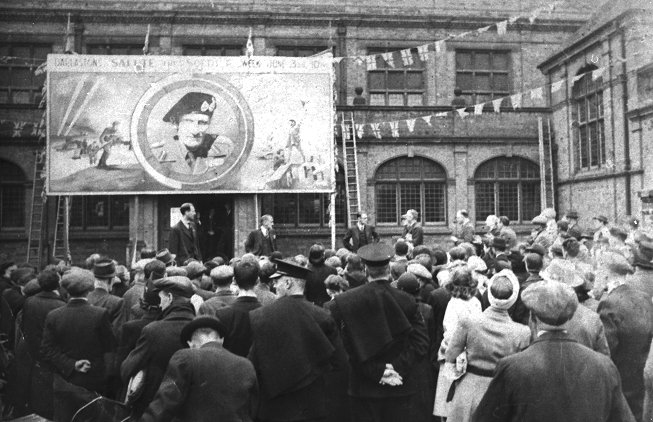
The poster was placed outside
the Town Hall. The photograph shows the opening
event on Saturday 3rd June, 1944. |
|
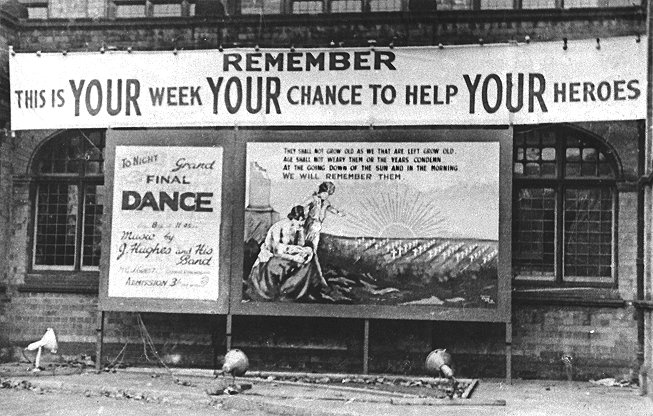
Another of Albert Peters' wartime
posters, also hanging outside the Town Hall. |
|

Albert's poster for the
National Savings Scheme. |
 |
Another wartime poster.
This one, from 1941, features Albert Peters' brilliant characterisation of the well-known scrap collector
Billy Muggins. |
|

Albert Peters standing beside
one of his many masterpieces. |
|
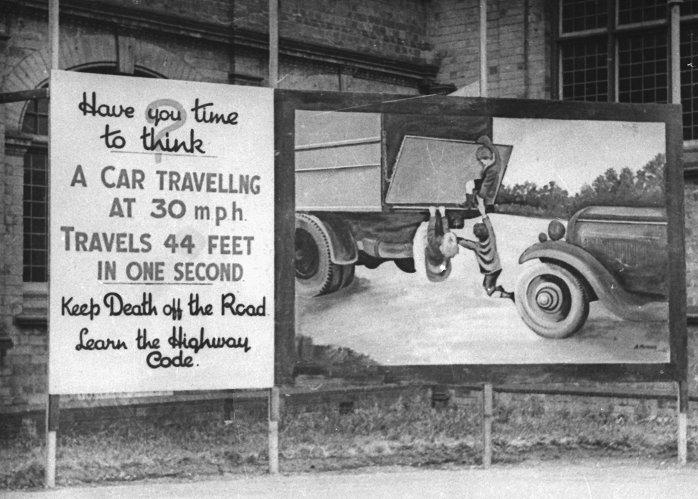
Another of his road safety
posters. |

A view of Campbell Place, as
seen from Blakemore Lane. Albert Peters and his
family lived in the shop in the centre of the photo.
From the collection of the late Howard Madeley. |
|

An advert from 1972. |
|
Royal visits
The Royal family played their
part in boosting people’s morale by visiting many of
the military, and industrial establishments that
were essential during the war. On the 26th February,
1941 King George VI and Queen Elizabeth visited GKN’s Atlas Works in Station Street, and on the 14th
January, 1943 the Duke and Duchess of Gloucester
visited the Rubery Owen factory.
The final part of the war
During the last few years of
the war it finally looked as though things were
going our way, although we still faced an intense
struggle with the German forces. Good news arrived
in November 1942 when the British and American
troops won the North Africa campaign. In September
1943 Italy surrendered, and in October declared war
on Germany. In June 1944 British and American troops
landed on the Normandy beaches (known as the D-Day
landings) at the beginning of the campaign to free
France from the Germans. In August the allied troops
landed in Southern France near Nice, and on the 20th
of the month reached Paris. On the 11th September,
American troops entered Germany.
The years of hard work and
shortages now seemed worthwhile, the threat of
German invasion was over, and people started to look
forward to the return to normality. With this in
mind, the government passed new legislation which
was designed to improve the education of young
people, and prepare them for their working life, and
career after school. This was the 1944 Education Act
which introduced the Eleven Plus examination. For
the first time, pupils were allocated a suitable
secondary schools, best suited for their abilities
and aptitudes. Three types of secondary school were
available, grammar schools, secondary technical
schools, and secondary modern schools. The Act also
allowed for the creation of comprehensive schools,
and created a system of direct grant schools, under
which a number of independent schools received a
grant from the Ministry of Education for accepting a
number of none fee paying pupils.
Also in 1944 it was made
compulsory for local authorities to provide school
dinners, which were free for children from low
income families. Good news
continued to arrive from Europe during the early
months of 1945. In April Russia launched its final
offensive on Berlin, and Adolph Hitler committed
suicide. |
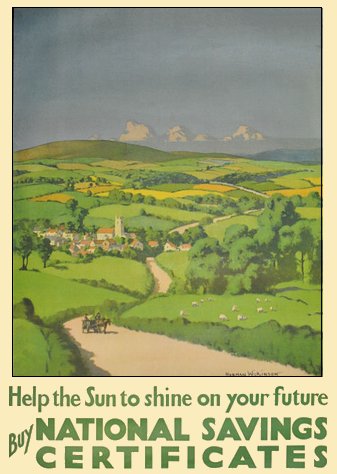 |
In May, Germany
surrendered, and on VE Day (Victory in Europe Day)
everyone celebrated the end of the war. There were
street parties, and bonfires, and families looked
forward to the return of their loved ones who were
still on the continent.
Working life soon returned to
normal because of the huge demand for steel goods,
and nuts and bolts. Rubery Owen also benefited from
the shortage of housing by producing large numbers
of pre-fabricated houses. Many of the women who
worked in the factories during the war were replaced
by men returning from the forces. People’s
expectations for the future were high, but the
shortages in the shops continued for many years, the
final rationing books being issued in 1954.
Fighting finally came to an end on the 14th
August when Japan surrendered to the allies. This
was universally celebrated as V-J Day (Victory in
Japan Day). The war had lasted almost 6 years, we
were in a poor financial state, and much of the
country’s infrastructure was in tatters. It would
take many years and a lot of hard work to recover. |

The VE Day street party that was
held in Lowe Avenue. Courtesy of Mavis Young.

|
Some of
the people in the photograph above |
| 1. |
Louise Bumford |
|
32. |
Betty Hall |
| 2. |
Mrs. Harris |
|
41. |
June Bumford |
| 3. |
Margaret Holdcroft |
|
42. |
Janet Bumford |
| 4. |
John E. Lawton |
|
43. |
Edna Hartshorne |
| 5. |
May Lawton |
|
48. |
Mavis Bumford |
| 6. |
Mrs. Clifford |
|
50. |
Margaret Rose Harris |
| 7. |
Mrs. Boffee |
|
51. |
Jeanette Clifford |
| 8. |
Mrs. Evans |
|
52. |
June Clifford |
| 9. |
Jack Hartshorne snr. |
|
55. |
Les Bumford |
| 10. |
Mrs. Stokes |
|
58. |
Ron Bumford |
| 13. |
Mr. Clifford |
|
59. |
Jack Hartshorne jnr. |
| 14. |
Mrs. Richards |
|
60. |
Leslie Bumford |
| 15. |
Bill Holdcroft |
|
61. |
Dennis Evans |
| 16. |
Ethel Stokes |
|
62. |
Daniel Richards |
| 25. |
Gillian Lawton |
|
68. |
Ria Rudge |
| 26. |
John Lawton |
|
70. |
Jack Rigby |
| The dog, a mongrel terrier, belonged to the
Hartshorne family and was called Mick. If you can
recognise anyone else, please
send me an email.
Thanks must go to Jack Hartshorne, Anthony Holdcroft,
Mavis Young, Florence Wilkes and Annis Spinks for supplying the names
of the people above. |

A programme for one of the many
celebrations that were held to mark the end of the war.
Courtesy of Christine and John Ashmore. |
Black country industries played
a vital role in the war effort. Thousands of firm
diverted much of their capacity to the production of
armaments, which often accounted for 90% of their
output.
One typical firm, the Wellman Smith & Owen
organisation, built specialised machinery for shell
forging, which was used in Canada, Australia, and
America. The machines produced in excess of three
hundred and fifty 3.7 inch aircraft shell forgings
an hour.
By the end of the war some 80 million
shells had been produced on the machines, using
2.125 million tons of steel.
Throughout the war years a
feeling of comradeship prevailed in Darlaston, even
though there were many shortages and hardships.
The large number of factories
could have been a frequent target for the German air
force, but luckily very few bombs fell on the town.
A total of 11 houses were badly damaged, and 401
were slightly damaged.
|

The inside of the souvenir programme
above. Courtesy of Christine and John Ashmore.
| Out of the many hundreds of
people from Darlaston who fought in the war, 93 were
killed. The plaque on Darlaston’s war memorial lists
12 civilians killed in the war. 11 of them were the
victims of the bombing in Lowe Avenue. Unfortunately
I have no information on the 12th casualty, Annie
Mitchell, who could have died from her injuries,
sometime after the bombing. |
|
 |
|
The plaque on Darlaston war memorial
dedicated those who lost their lives due to enemy action
in the Second World War. |
|
| |
|
|
|
|
Read about a
forgotten
war hero |
 |
|
Read about Darlaston
war memorial |
 |
| |
|
|
|
|
 |
After the war had ended, Darlaston Council held
an exhibition in the Town Hall to inform people of
its many roles and activities.
Courtesy of Christine and
John Ashmore. |
|
The early post war years
The 1950s and 1960s saw
Darlaston at its most prosperous. It grew to be the
leading centre in the country for the manufacture of
nuts & bolts, and its many products were exported
all over the world. Darlaston's complete domination
of this industry covered all types of nuts & bolts,
screws and rivets. Thousands were employed in the
industry and a very high degree of skill and
craftsmanship was shown by them.
The many other engineering
concerns in the town also prospered, producing a
diverse range of products including forgings,
cycles, machinery, castings, holloware, motor
components, and structural steelwork. Other products
included soap, candles, rope and twine.
A full and flourishing
industrial and economic life appeared to be assured
for the people of Darlaston, with many varied and
interesting opportunities for the younger
generation. |

Darlaston war memorial. |
| In 1952 the new All Saints Church in Walsall
Road opened as a replacement for its predecessor,
which was destroyed by the German bomb in 1942. The
new church, designed by Lavender & Twentyman of
Wolverhampton was built by E. Fletcher of
Kingswinford at a cost of £38,320. |
 |
The
western end of Foundry Street in
the mid 1950s. All traces of the
street have now disappeared.
It
ran from Catherine's Cross to
Wiley Avenue, in parallel with
Park Street.
The houses are
identical to much of the town's
cheaper mid Victorian dwellings,
which were demolished in the
1950s and 60s. |
|
Marion Turner, whose husband Malcolm
grew-up in the late 1930s and 1940s at number 35 Foundry
Street has kindly sent a list of the residents of the
properties in the above photograph, during those years.
They are as follows, from left to right:
| Number
34 |
George and Sarah Turner, grandparents of
Malcolm in number 35. |
| Number
35 |
George and Kate Turner, and their
children Malcolm and Kenneth. |
| Number
36 |
Mr. and Mrs. Lloyd and their children,
Jeffrey, Janet and Ann. |
| Number
37 |
The Palmers, brother and sister. |
|
Coal Yard |
The Simpsons who also owned
the adjacent shop. |
| Past the shop lived the
families of Hawkins, Upton and Thomas. |
Malcolm Turner went to Pinfold Street
School, and his father George worked for many years as a
machine bolt header for Guest, Keen & Nettlefolds. |
|
The council's housing development
schemes continued at a rapid pace. The older substandard
houses completely disappeared by the mid 1960s.
Over 2,000 council houses had been built since the end
of the war, including the Bentley Estate, which had
shops, a library, a Parish Church, and two secondary
modern schools.
|

An advert from 1954. Courtesy of
Christine and John Ashmore. |

The front cover of a 1954 council
tenant's handbook. Courtesy of Christine and John
Ashmore. |
|

Kate
Turner and her son Malcolm at the back door
of 35 Foundry Street. The photograph
was probably taken in 1936. |
 |
 |
 |
Return to The
Inter-War Years |
Return to
Contents |
Proceed to The
Post-War Years |
|